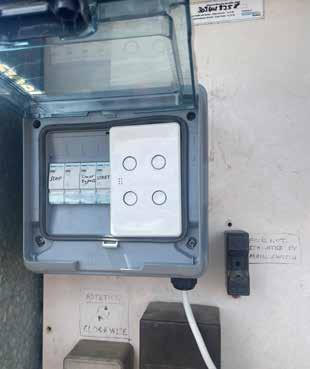
2 minute read
INVESTIGATING LOW-COST IRRIGATION TOOLS
- CENTRAL DISTRICT PRODUCTIVITY PLAN
Finding and promoting low-cost irrigation management tools is one of the activities aimed at increasing the use of irrigation as part of the Central District Productivity Plan this year.
Advertisement
With an engineering degree under his belt, Central District Manager Dylan Wedel is well qualified and keen to assist growers with their irrigation systems and help them make more money with their water.
“With the help of District Delivery Officer Stephanie Duncan, I’ve been able to solve some irrigation problems for local growers with simple tools that are low cost and available off the shelf at their local hardware store, for example,” Dylan said.
“We’ve also got Chameleon soil moisture probes available at SRA Mackay for growers to try before they buy,” he said.
Wifi pump controller

“The home automation market has provided a range of simple devices that can easily be adapted to farming challenges.
“These devices all communicate back through the GridConnect smartphone or tablet app which enables automation of the system,” Dylan said.
“For example, in one trial, we used a fourbutton smart light switch to control a set of contactors that were then wired into the control circuit of an electric pump.

“Using GridConnect on a smartphone we could then activate the On and Off buttons, and even bypass the pressure switch and timer at start up to allow for a complete handsfree operation to run a pump. GridConnect also removes the need for a manual timer because a countdown timer can be set through the app to turn the pump off.”
Battery powered multipurpose wifi sensor
“We’ve found a door/window alarm sensor which has the ability to be attached to any type of switch-based sensor e.g. to limit switches, float valves and auxiliary contactors in a pump starter,” Dylan said.
“This provides a notification back to a smartphone when any of these are triggered. We’ve used one of these as an end of row sensor with a float switch that we could link to automation using the GridConnect app, turning the pump off when activated.
“This is also our main method of monitoring when a pump is started and stopped. A notification is received when an irrigation set is complete or if there has been an issue. We’re also working on combining this with a frequency counter and rotary encoder to provide updates to a smartphone showing how quickly an irrigator is moving through the paddock.”
Pressure switch gauge
“When I mentioned pressure switch gauges to growers at the MAPS/SRA Field Day in May, they would describe a big red Murphy switch, but these are becoming harder to come by and are relatively expensive. Digital alternatives have a similar cost. However, there are 50mm diameter gauges with a range of switch configurations and voltages available for around $200,” Dylan said.
“These gauges when set correctly provide peace of mind that, if a pipe, rubber seal or hose burst, the pump will shut off and you won’t end up with a flood.
“When it comes to the remote control of pumps, having a Murphy switch saves you from having to report pressure back to your phone. While your pump is running, it will only operate if the pressure is in an acceptable range. Currently, live pressure monitoring isn’t conveniently available off the shelf at your local hardware store.”
Chameleon soil moisture probe
“For less than $300, you can monitor soil moisture at three different depths as well as temperature, with readings being uploaded to a website every two hours,” Dylan said.

SRA Mackay has a Chameleon soil moisture probe (pictured) that growers can borrow on a ‘try before you buy’ basis.
“Having this information live at your fingertips allows for more timely irrigation to maximise growth before the crop is stressed. We’ve deployed a number of these across the district in different soil types. Daily stalk growth measurements have shown the optimum time for irrigation based on the data that the soil moisture probe displays.
“The crop draws down the moisture in the soil at an incredible rate - at one site it took only five days for the crop to draw the available water out of the top 75cm of soil after an irrigation.”








